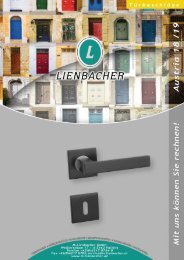Create successful ePaper yourself
Turn your PDF publications into a flip-book with our unique Google optimized e-Paper software.
E | F | I
Direction determination
1. Door hinges are attached on the inside on the left
= left (handle points inside to the left to the hinges)
2. Door hinges are attached on the outside left
= right (pusher points inside to the right)
3. Door hinges are attached on the inside right
= right (pusher points inside to the right to the hinges)
4. Door hinges are attached on the outside right
= left (pusher points inside to the left)
Utility classes
Applications area:
The Norm applies exclusively to door handles
and knobs (with or without spring, on plate or
rose as well) with which you can activate a
latch or a lock.
The Norm laid down test methods and
requirements:
• spindle and fastening elements
• operation cycles
• permissible free play and safety
• functional longevity
• static strenght and corrosion resistance
• DIN EN 1906 was published May 2002 and
has appeared in every memeber country has
the status of a national Norm. Supplementary
German standards are the DIN 18255:2002-05
and the DIN 18257:2003-3
Category of use (Cl.4 has been set )
Class 1: low frequency of use by people with
a high incentive to exercise care and a small
chance of misuse, e.g. internal residential
doors
Class 2: medium frequency of use by people
with some incentive to exercise care but
where there is some chance of misuse, e.g.
internal office doors
Class 3: high frequency o fuse by public or
others with little incentive to exercise care
and with a high chance of misuse, e.g. public
offices doors
Class 4: for use on doors with extremly high
chance of misuse e.g. football stadiums or
schools
Use on fire & smoke protection doors
Class 0: not approved for fire
Class 1: suitable for fire
Safety-Personal protection
Class 0: no requirement
Class 1: in event of security requirement
Corrosion resistance
Class 0: no corrosion requirement
Class 1: low corosion resistance
Class 2: moderate corrosion resistance
Class 3: high corrosion resistance
Class 5: extremly high specified corrosion
resistance
Security-Burglar protection
Class 0: fitting are not suitable for
installation on burglar
resistance doors
Class 1: low burglar resistance
Class 2: moderate burglar resistance
Class 3: high burglar resistance
Class 4: extremly burglar-resistance
Distance norms
Keylock
Cylinderlock
Toiletlock
Austria
90 mm
Austria
88 mm
Austria
90 mm
Germany
- Roomdoor 72 mm
Switzerland 78 mm
France 70 mm
France 72 mm
Czech Rep. 72 mm
Czech Rep. 90 mm
Hungary 90 mm
Hungary 55 mm
Germany
- Roomdoor 72 mm
- Frontdoor 92 mm
Switzerland 78 mm
- Kaba 78 mm
France 70 mm
France 72 mm
Czech Rep. 72 mm
Czech Rep. 90 mm
Hungary 90 mm
Hungary 55 mm
Germany
Switzerland
France
France
Czech Rep.
Czech Rep.
Hungary
78 mm
78 mm
70 mm
72 mm
72 mm
90 mm
90 mm
Spindles
Toilet Spindles
Austria 8,5 mm
Germany
- Roomdoor 8 mm
- Frontdoor 10 mm
Switzerland 8 mm
France
France
Czech Rep.
Hungary
7 mm
8 mm
8 mm
8 mm
11
Austria
Germany
Switzerland
7 mm
8 mm
7 mm
France
France
Czech Rep.
Hungary
6 mm
8 mm
6 mm
8 mm
















